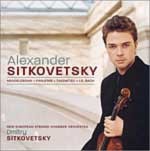strings(8.6.4.4.2)
Abbreviations (PDF)
Boosey & Hawkes
When Yehudi Menuhin asked me to compose a violin concerto for him, I immediately had in mind his unique spiritual and poetic qualities and I felt I should provide a vehicle which would accentuate these rare gifts, and not obscure his deep inner musicianship by virtuoso pyrotechnics.
I treated the violin as a singing instrument so, though keeping within my strict self-imposed discipline of sound-organisation, I constructed rather long and unbroken melodic lines. To further expose the solo part and keep it ever-prominent, as well as to achieve a specific colour and texture, I chose to use an orchestra consisting only of strings.
The Violin Concerto is composed in three movements:
- The Rubato starts with a quasi-cadenza, like an improvisation on one triad. This musical material is carried over to the orchestra as a background while the soloist introduces a long cantilena, characterised by a repeated descending sequence of two intervals, minor second plus major third. This is followed by a new, syncopated thematic idea built on a different triad, this time consisting of minor thirds. In the flow of the music, the solo cantilena re-emerges and the movement ends with the shortened quasi-cadenza. The whole movement is very flexible in tempo (as indicated by the title) in order to give the soloist much freedom of interpretation - in contrast to the steady tempi of the other two movements.
- Adagio is built on alternating minor and major thirds, which the orchestra introduce and which are then taken up by the soloist. I wanted to write this movement with utter simplicity and frugality of means but with much Poetic content, again giving the soloist the opportunity for self-expresssion to speak profoundly through a sparse and most transparent framework.
- The Vivace continues the explorative use of minor and major thirds. However, in the second section, the mirrored melodic line is constructed on a triad consisting of minor thirds, a kind of elaborated reflection from the first movement. Throughout this movement, the emphasis is on the rhythm and constant cross-rhythms, except in the middle section where the soloists play a long cantabile sequence on the G string, interrupted from time to time by short interjections from the orchestra. In this almost dance-like movement, I wanted the soloist to convey the most human feelings of joyousness, vitality and even some sense of humour.
Andrzej Panufnik
Reproduction Rights
This programme note can be reproduced free of charge in concert programmes with a credit to the composer

Alexander Sitkovetsky/New European Strings Chamber Orchestra/Dmitry Sitkovetsky
EMI (Angel records) 7243 5 57440-2 0
Click here to purchase this CD set from Amazon
